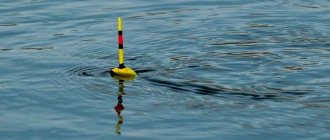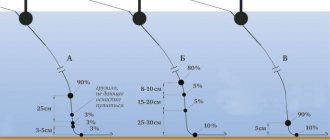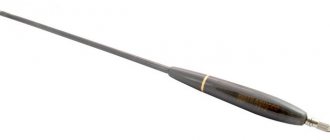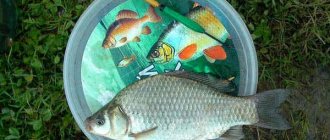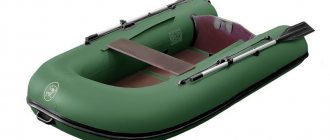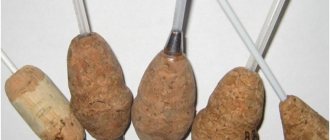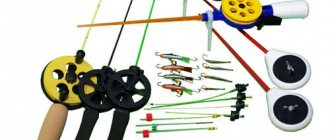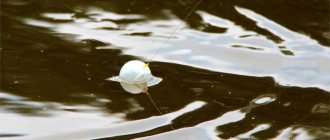How to choose a float?
How to choose a float or which float is better? This question is often asked by fishermen, especially beginners. Since the range of float shapes is very wide: from long and narrow to thick and spherical, it can be difficult to decide on the choice of float.
The general rule when choosing floats is: the calmer the water, the thinner the float required; the stronger the current, the thicker it should be.
Here (see figure) is a small selection of float models, the scope of which extends from a standing reservoir (float 1) to a fast-flowing river (float 10).
- A float with a narrow body and a flat top. This plane is stabilized by the surface tension of water. When accurately loaded, such a float becomes a very sensitive bite alarm in calm water.
- A slender float with a body that gradually tapers up and down. In calm water it remains stable even with a small current. A float of this shape is well suited for lakes and canals with weak currents.
- Thanks to its low center of gravity and narrow neck, this float resists waves quite well. The antenna rises and falls with the waves and only when there is a bite it goes completely under the water.
- This float has a low center of gravity, but the body is more compact than float No. 3. The very long keel stabilizes the float when being pulled slowly or held in light current.
- A teardrop float is a classic choice for slow-moving rivers. When there is no wave, it provides a reliable bite alarm if alternately let out to drift or held.
- The float is a double-sided cone. Thanks to its long keel, it has good stability in weak and medium currents. Floats of this shape are often used when fishing on canals.
- The thick teardrop-shaped body and long keel help stabilize the float in fast-moving water. The eyelet for passing the fishing line is placed very high. Thanks to this, the float does not come out of the water when held in the current.
- A float with an almost spherical body, even more compact than a teardrop-shaped one. The line passes through the body of the float, thanks to which it can withstand a higher load when holding and hooking in a strong current.
- The inverted teardrop-shaped body provides the float with greater lift when it is just below the surface of the water. This float does not sink, even if the current pulls it to the bottom.
- Flat float for fishing in currents. The disc-shaped body with eyes for passing fishing line on the beveled edge has minimal windage in the current. When braking hard, the antenna remains in a stable position, and the float body does not rise out of the water.
Attaching floats for fly fishing
The float can be attached to the fishing line at one or two points. The main attachment point is the very bottom of the float. The attachment point for the float on the fishing line consists of two parts: the actual attachment to the fishing line and the connection link between the attachment and the float. It is possible to directly attach the float to the fishing line. The attachment point on the fishing line can be blind or sliding. A blind mount is used when the fishing depth does not exceed the length of the rod. A sliding mount is used if the fishing depth is greater than the length of the rod. In fly fishing, a blind mount is more often used.
When fishing in a canal or in still water, floats of a special design should be used, the center of gravity of which is low enough. These floats have the shape of a drop.
If you are fishing in a river, olive-shaped floats are best, as they are indispensable when fishing in the current.
Blind mount
provides a permanent location for the attachment point on the fishing line - it cannot move spontaneously and can be moved with difficulty. The design of the unit consists of a cambric placed on a fishing line and a rod with which the fishing line is clamped in the cambric. The rod is connected to the float. The connection between the rod and the float can be rigid and hinged.
When hard
When connected, the float and fishing line form one whole - the float is motionless relative to the fishing line. The fastening of floats without rings is rigid. For example, a fishing line passes through the body of a float and is secured by a rod. When attaching a float with a keel that does not have a ring, the keel is used as a rod that clamps the fishing line. Usually, on a smooth keel, the line is attached with two cambrics - one cambric at the end of the keel, the second - under the body of the float. This results in a rigid mount.
When hinged
connection, the float hangs freely on the attachment point to the fishing line. This is usually how floats are attached with a ring at the bottom. The fastening unit is made of wire. The wire is threaded into the ring of the float, bent, and its ends are twisted. The cambric is selected according to the diameter of the twist. To attach heavy floats, a loop is made in the middle of the rod, which is passed into the ring on the float. Cambrics are put on the ends of the rod, through which the fishing line passes.
The rigidly fixed float is well controlled - when pulled up with a rod or released in the current, it maintains a vertical position. Casting such a float requires care. At the beginning of casting, when the line is behind the angler’s back, the position of the float is with the antenna towards the tip of the rod. After the cast is completed, the float flies with its antenna forward, the float antenna is directed away from the rod. Before splashdown, when the fishing line is pulled, the float is turned over by the antenna towards the rod. When the float is turned over, the antenna may get caught on the fishing line, and, as a result, the antenna may become loose and fall out.
Elements of a fishing float and their influence on its characteristics
The three main elements of a float are the antenna, body and keel. When choosing a float for fishing, it is a good idea to know how these elements of the float affect its characteristics and sensitivity.
Float antenna.
One of the requirements for a float is that it must be visible in all fishing situations (against the sun, waves, rain, wind) so that you can make an effective hook as soon as you see a bite.
The visibility of the float primarily depends on the antenna, the main task of which is to signal a bite. The antenna must be clearly visible and at the same time have low windage and good sensitivity. In order for the bite to be clearly realized, the fish should not feel the resistance of the float when it takes the bait.
The ideal compromise is achieved by using an antenna that matches the fishing conditions and the type of fish. The choice of antenna depends on the state of the water and lighting during fishing.
How to increase the visibility of the float antenna during changing conditions, even during one fishing trip?
- change the color of the antenna using special paint;
- paint the antenna with fluorescent paint or make it thinner in order to put on a fluorescent plastic tube;
- use floats with replaceable antennas;
- use replaceable hollow antennas.
The visibility and sensitivity of the float depending on the antenna material.
The visibility and sensitivity of the float depends not only on the shape of the antenna, but also on the material from which it is made.
Topless. A float without an antenna (the so-called Dibber) is lightly weighted, only surface tension keeps its tip above the water. The Dibber is very visible thanks to its wide head. Such floats are suitable for use with bulky baits, such as corn, and for catching large fish such as carp, which bite quite sharply and accurately.
Heavy steel. In good light conditions, floats with a steel antenna are unsurpassed. They note not only quick bites, but also careful tugging of the bait. But steel antennas are difficult to see in strong backlight because the sun does not shine through the steel. The antenna's carrying capacity is negative due to the material. Therefore, floats with steel antennas require a very thin weight.
Light fiberglass. Fiberglass antennas are more visible in low light conditions than steel ones. Fiberglass allows the sun's rays to pass through it, so antennas made from it have a fluorescent glow effect. Such a float clearly reacts to the slightest touch of a fish on the bait. But it works well only in calm water, and on a wave it fluctuates, simulating false bites.
Stable plastic. Plastic antennas are best visible: in windy weather and during waves. Floats with such antennas are very stable, easy to load, and they respond well to bites. But sometimes these antennas are difficult to see due to their small diameter.
Hollow plastic. Hollow plastic antennas are clearly visible due to their large diameter. Even in low light they guarantee good bite recognition. Replacing large baits with small ones does not greatly affect the position of the antenna. The price you have to pay for this is that the antenna does not detect bites so sensitively.
Floating bamboo. Bamboo antennas have excellent load-carrying capacity. Floats with such antennas are good when the fish takes the bait in the falling phase. In strong waves and wind, the bamboo antenna reduces the swaying of the float's body and is always ready to signal a bite. But due to its high buoyancy, it is not very sensitive.
Various shapes of floats
Depending on the conditions under which fishing will be carried out, you need to choose the right float. According to their form, they can be divided into several types.
Spindle shape
One of the very common forms, in which the keel and antenna are almost comparable in thickness to the hull itself. Ancient floats based on goose feathers can also be attributed to this form. The shape of the spindle allows the device to have increased sensitivity, which means signaling not just a bite, but even that the fish has touched the bait. Such indicator buoys are perfect for lake fishing (in still water) and for calm weather. Their main disadvantage is that even with a weak wind they begin to “lie down” on the water surface or even “dive” - all this will make it difficult to signal a bite. Another disadvantage is their reduced carrying capacity (only 2-3 grams). And in general, with such devices it will be difficult to cast the fishing rod far. They are most suitable for fishing close to the shore.
olive shape
This form is considered more universal. Indicator buoys of this shape can be used not only on lakes/ponds, but also on rivers with gentle currents. They have little tendency to react to small winds causing small ripples in the water. Their distinctive feature is that they very clearly signal a bite (however, for this it is necessary to correctly place/balance the sinkers and bait). The main area of application is fishing with a fly rod at shallow depths (up to three meters).
teardrop shape
Such a buoy can be called a modernized version of the “olive”. Such devices are distinguished by maximum stability in reservoirs with medium currents. Stability is achieved by thickening the hull at the point where the keel is attached, therefore, their center of gravity shifts downward. Their versatility means that they can be used with almost any type of equipment, however, it is advisable to fish with them at a depth of up to one and a half meters.
Ball shape
One can directly call such an indicator buoy a logical continuation of the “olive” shape. They differ slightly in shape, but their scope of application is the same. It is worth noting that the spherical type is slightly inferior to the “olive” type in terms of sensitivity.
Inverted (upside down) drop
A specially designed option for fishing in strong currents. They have the greatest resistance potential, unlike all those described above. Such a buoy is convenient to use in cases where it is necessary to hold the float during free swimming (for example, fishing from a moving boat). Often such devices are used in Bolognese fishing rods.
Flat shape
These floats are made in the form of a flattened disk, and the keel and antenna are attached to it at the same level (however, a small angle is set between the keel and the antenna). These indicator buoys are the most effective when fishing in strong current conditions. Moreover, to “spot” the float in the design, special rings can be used (installed either directly on the hull or on the keel - a little closer to the antenna).
In some cases, the ring can be replaced with a special tube passing through the body. This is done so that the line cannot damage the body when making long casts, or when sharply hooking a fish. It is worth noting that winding rings can be made of metal or plastic (it is used mainly in Chinese models), however, as practice shows, it is better to refuse the latter, because they are easily cut by fishing line after even a dozen long casts.
Float body
In order for the equipment to work more effectively and you can force the fish to take the bait, it must be well controlled, regardless of the fishing conditions (wind, bottom current, etc.). And this largely depends on the shape of the float body.
The main shapes of the float body: oblong, pear-shaped, teardrop-shaped, bulbous.
The body is oblong in shape. Floats of this shape show good bites on the rise. The oblong body has very little inertia (it requires very little effort to be pulled under water), so timid fish will not abandon the bait before you hook it.
Drop-shaped body. These are the most versatile floats.
The body is bulbous in shape. Floats with such a body are used for fishing in strong currents. Thanks to this shape, the float does not rise out of the water when held down or in strong winds and remains in the working position, allowing the fisherman, if necessary, to manipulate the equipment, tempting the fish to bite.
Float mounting ring.
The position of the fastening ring determines how well you can control the operation of the float. The higher the ring is on the float, the less the float comes out of the water when held. A ring attached to the antenna is an excellent option when fishing in difficult conditions, especially if the float is equipped with a keel that runs inside to the junction of the antenna and the body.
Float keel.
Which keel is better to choose, short or long? The short keel allows the float to quickly take its working position in the water. Floats with such a keel are ideal for high-speed fishing for bleak and small roach. The long keel makes the float much more stable when fishing at great depths. It is less affected by waves or water movement resulting from the operation of canal locks. It is also easier to stop at the point you want, and it does not dive under water when making empty hooks. Use floats with a long keel when fishing in large canals, slow-moving rivers and deep lakes.
Floats for fly fishing
A float is a fishing device on the line of a float rod. The float performs two functions: the first - holds the hook with a fishing attachment at the desired depth, the second - signals a bite.
A fly rod is designed for fishing close to the shore or boat. This type of gear is used in bodies of water with standing water. Therefore, the floats are characterized by low weight and low load. The high sensitivity and quiet splashdown of the fly rod float after casting allows you to notice the weakest bite.
Materials from which float keels are made and their effect on the general characteristics of the float
The keels of floats, like antennas, are made of various materials, which also affect the behavior of the float.
The steel keel, due to its mass, stably holds the float vertically on the water, even in the wind. In a current, a steel keel has less resistance to water than keels made of other materials. A steel keel allows you to use small floats with a lightweight body and antenna. This real advantage manifests itself when ultra-delicate fishing is required.
Fiberglass keels are very hard and durable. Floats with keels made of this material are used primarily for Bolognese and carp fishing, where a very durable, unpretentious float is required that can experience heavy loads.
Bamboo keels are very light and have a high load capacity, so they are used for fishing when the float has to withstand a significant influence of the weight of the sinker and bait. Floats with a bamboo keel are also good for fishing with slowly falling bait in the middle layers of water.
The keels of carbon fiber floats work well when the bait is strictly vertical under the float.
This type of keel material is used in deep reservoirs without a current or when fishing for line fishing in channels with very weak currents. In strong currents or windy conditions, floats with carbon fiber keels, on the contrary, spin in one place and do not respond very accurately to bites. Source
Loading capacity of floats for fly fishing
The body of the float, the dimensions of which must correspond to the weight of the sinkers and bait, determines its carrying capacity. It is calculated in the following arithmetic way: the difference between its volume and weight. With the same size, but with different material densities, the float has a different load capacity (the higher the material density, the lower the load capacity). Floats with variable load capacity are available for sale.
Thus, the choice of a float used for certain fishing conditions depends not only on the shape of its body, but also on the carrying capacity. When choosing a float, the following conditions should be taken into account:
- type of fish;
- the diameter of the fishing line on which the equipment will be installed;
- depth at the fishing site;
- level of fishing gear, as well as fishing method;
- presence of current;
- weight and size of the bait (for example, when fishing with live bait).
Loading floats for fly fishing
For the float to become a bite indicator, it must be firmly connected to the hook with the nozzle. The fishing line between the float and the hook in a free state cannot achieve the required rigidity of the connection. To give the fishing line the necessary rigidity, it must be tensioned.
To do this, a sinker is attached to the fishing line closer to the float, which with its weight should pull the fishing line into a line. The thicker the line or the greater the drop (the distance between the float and the hook), the heavier the sinker should be. It is believed that when fishing in still water, for every meter of depth, it is necessary to increase the weight of the sinker by 0.5 - 1 g. The weight of the sinker when fishing in a current can be greater than when fishing in still water.
To prevent the float from sinking under the weight of the sinker, it must have sufficient lifting capacity. On modern floats their carrying capacity is usually written. In order for the float rig to be cast confidently, it must have sufficient weight. Equipment smaller than 1 g is difficult to cast with a long rod even in calm, windless weather. The maximum weight of equipment cast with a float rod should not greatly exceed the rod test.
